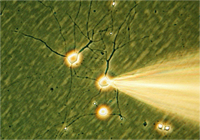ION CHANNELS IN NEURONAL EXCITABILITY AND DISEASES
Department: Neuroscience
Research subject
Our work in Lory’s team is dedicated to studying the properties of voltage-gated calcium channels (Cav) and the sodium leak channels (NALCN). These ionic channels are essential players in monitoring and regulating the electrophysiological activity of excitable cells, especially neurons. A dysfunction of these channels can lead to a large variety of neurological diseases (epilepsy, migraine, ataxia, chronic pain, autism...) designated "channelopathies".
The objective of our work is to better understand the involvement of these channels in physiology and pathophysiology. We study different aspects of their modulation combining electrophysiology with complemetary approaches, such as mass spectrometry. A major effort was made to decipher how T-type calcium channels (Cav3) are modulated by endogenous ligands (lipids, zinc, calcium, phosphorylation...). We also investigate the pathogenic mechanisms underlying calcium and NALCN channelopathies (epilepsy, ataxia, neurodevelopmental disorders, etc.) and we develop and characterize animal models (mice, zebrafish) of these diseases to explore innovative therapeutic strategies.
Our team is part of the Laboratory of Excellence (LabEx) "Ion Channel Science and Therapeutics" (ICST) and was granted FRM Team 2017.
Team
Major publications
- Bouasse M, Impheng H, Servant Z, Lory P, Monteil A (2019). Functional expression of CLIFAHDD and IHPRF pathogenic variants of the NALCN channel in neuronal cells reveals both gain- and loss-of-function properties. Sci Rep. Aug 13;9(1):11791.
- Chemin J, Siquier-Pernet K, ... , Lory P, Cantagrel V (2018). De novo mutation screening in childhood-onset cerebellar atrophy identifies gain-of-function mutations in the CACNA1G calcium channel gene. Brain. 2018 Jul 1;141(7):1998-2013
- Cazade M, Bidaud I, Lory P, Chemin J (2017). Activity-dependent regulation of T-type calcium channels by submembrane calcium ions. Elife. 2017 Jan 21;6. pii: e22331.
- Blesneac I, Chemin J, Bidaud I, Huc-Brandt S, Vandermoere F, Lory P (2015). Phosphorylation of the Cav3.2 T-type calcium channel directly regulates its gating properties. Proc Natl Acad Sci U S A. Nov 3;112(44):13705-10.
- Coutelier M, Blesneac I, Monteil A, Monin ML, Ando K, Mundwiller E, Brusco A, Le Ber I, Anheim M, Castrioto A, Duyckaerts C, Brice A, Durr A, Lory P, Stevanin G (2015). A Recurrent Mutation in CACNA1G Alters Cav3.1 T-Type Calcium-Channel Conduction and Causes Autosomal-Dominant Cerebellar Ataxia. Am J Hum Genet. Nov 5;97(5):726-37.
- Chong et al (2015). De novo mutations in NALCN cause a syndrome characterized by congenital contractures of the limbs and face, hypotonia, and developmental delay. Am J Hum Genet. Mar 5;96(3):462-73.








